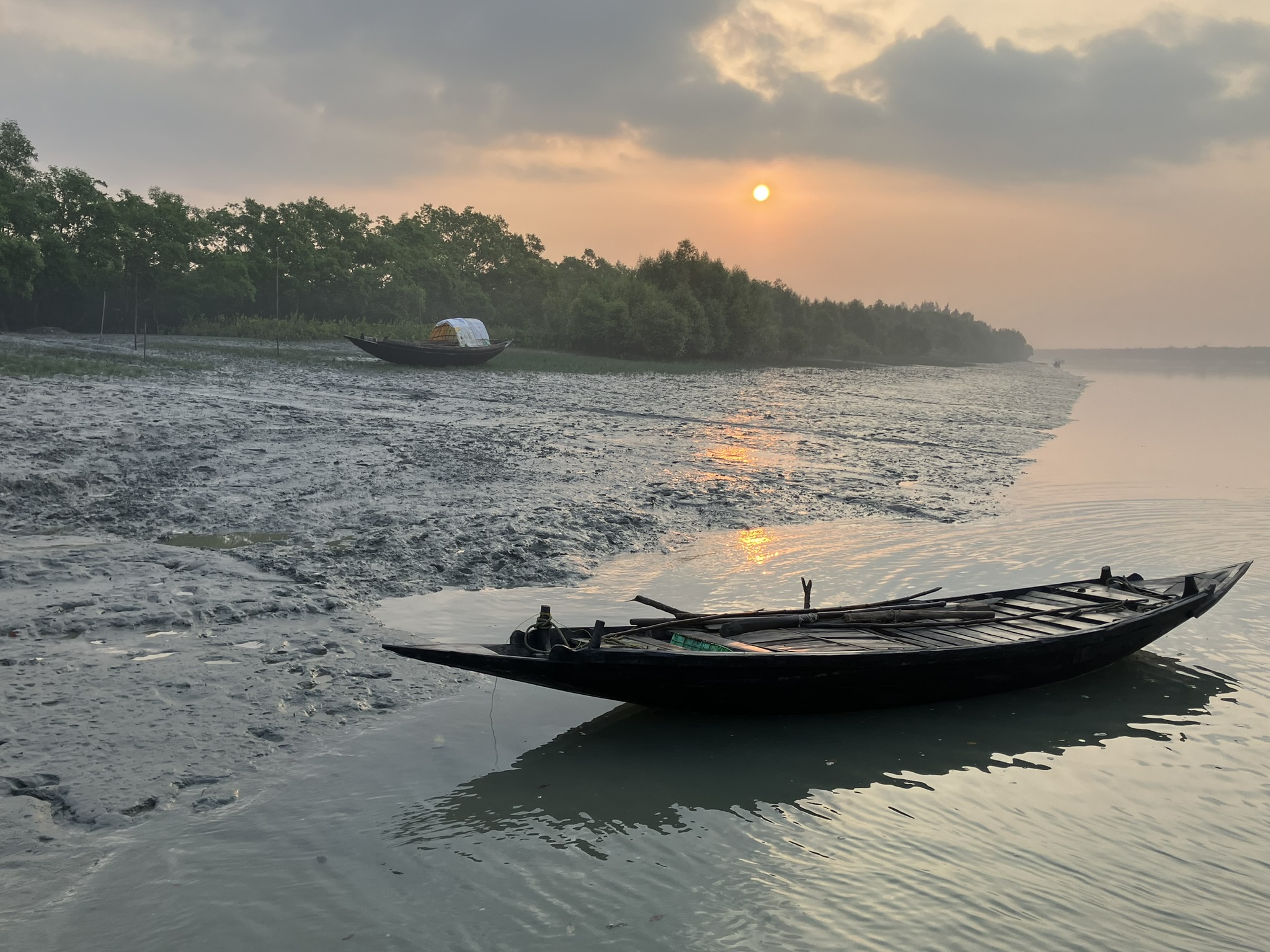The morning air in Basanti was warm, with smog draped over the pink-orange sunrise like a thick layer of grey chiffon. After a 2-hour drive southeast from my Dadu Ji’s (granddad’s) house in Kolkata, we had reached the far edges of the state of West Bengal and indeed the outer borders of the country of India, but we had not yet escaped the ring of air pollution that surrounds the city center.
The streets of Basanti town were abuzz with shopkeepers preparing their wares, mother cows bellowing to their young, and tropical birds cheerfully singing the tunes for which they were named: papiha (Common Hawk-Cuckoo), kokila (Asian Koel), kowah (Crow). Their songs were underscored by the incessant thrumming of mosquitoes, menacing man and animal alike as they flitted in search of their next victims. Mosquitoes, I believe, were put on this planet to humble humans — after all, their mere presence reduces us from power-hungry predators to paltry prey.
We unloaded our car briskly, swatting the air vigorously all the while, then made our way to the waterside, where a sign welcomed us:
Sundarbans National Park & Tiger Reserve

A boat and its crew awaited us at the dock: the Delta Queen, captained by a majestically mustached man named Mrittunjoy. The Delta Queen was our ticket into the Sundarbans, the world’s largest mangrove forest situated within the world’s largest river delta. Spanning two countries (India and Bangladesh) and nearly 4,000 square miles, this region boasts a wide range of flora and fauna, with over 200 bird species alone. But the jungle, we were told, was full of terrible dangers—ranging from tree roots to tigers to territorial bees – and thus the water was the safest place for us to observe its biodiversity.

Mangrove trees are unique in that they have aerial roots or “breathing roots” that grow up and out of the water-logged soil. This incredible adaptation has enabled mangroves to thrive in extremely harsh, saline environments; however, these breathing roots are also very sharp and hazardous for land-dwellers.

Just as the sun began to peek out from behind its ashen curtain, the Delta Queen embarked on its 3-day journey into the Sundarbans Delta, where the sacred Ganges River empties into the Bay of Bengal. Mrittunjoy had a keen eye for spotting birds, and he promptly began to point out Kingfishers concealed in masses of mangrove roots. He soliloquized about the species of the Sundarbans; about the sea and its stringent saltiness; about the sweets that might be served at snack-time. Within only a few hours, we had seen deer, monitor lizards, birds of prey, and hundreds of mudskippers along the canal shores.

Then, in the late afternoon, as our boat wove down a wider waterway, my sister leapt up from her seat and pointed excitedly towards land. I craned my neck, hoping to catch a glimpse of an elusive Bengal tiger. Instead, I saw…

A woman. She balanced a pot on her head as she retreated from the riverbank, the pleats of her sari swaying in time with her gait. I squinted at this sight, struggling to see what had attracted my sister’s attention.
“People live out here?” my sister asked in awe.
Despite the dangers advertised to us, people do in fact live out there: 4.5 million on the Indian side and even more in Bangladesh. Much of the Sundarbans is protected as a nature reserve, but this region is still one of the most densely populated in the world. The fertile floodplains surrounding the delta are ideal for agricultural production, and there are small fishing villages on the islands within the delta. These settlements are simple and extremely rural, sometimes only accessible by boat.

Discomfort settled over me as I realized that we had been observing these villagers with unabashed scrutiny, just as we had been observing the flora and the fauna. They’re not here for my viewing pleasure, I scorned myself. Yet, I couldn’t tear my eyes away. The sight of this woman was jarring, I realized, because her life was so necessarily attuned and inextricably tethered to the patterns of the earth: the comings and goings of the rains, the cycles of the moon, the ebbs and flows of the tide. Every morning, while I stumble to my bathroom and turn on the tap, this woman carries a pot down to the riverside and fetches her water straight from the Sundarbans Delta. Though united by our shared humanity, I couldn’t help but feel species away from her, as distant as I felt from the exotic Kingfishers.

Over the remainder of our jungle cruise, Mrittunjoy pointed out local fishing boats and informed us about the villagers’ practices of collecting honey from wild rock bees. He explained that the locals fish the delta from June to December, then pause all fishing activities and collect honey between March and May to ensure sustainable harvesting practices. As he continued to intersperse facts about the local people’s customs with his commentary on cobras and crocodiles, my unease grew. I became acutely aware of the separation between us and them; between our tour boat and the Sundarbans – their home.
Indeed, from the safety of our tour boat, it was all too easy to view these villagers as another species altogether; to assume that they are somehow less susceptible to the forecasted dangers of the Sundarbans simply by virtue of surviving there everyday. This is not the case. The villagers enter the jungle at their own peril, for tiger attacks are common. Yet, they have no choice; aquaculture and beekeeping are the only ways for them to make a living. In this way, the villagers are equal contributors to the Sundarbans ecosystem; they survive on the offerings of the jungle, at any time prone to becoming offerings themselves – whether to tigers or to mosquitoes. Sometimes predators, sometimes prey, these villagers remind us that humans are but one species acting within complex, multi-species ecosystems. They challenge the illusion that humans are always, unequivocally, at the top of the food chain.





Some more breathtaking captures of the Sundarbans food chain by my uncle, Partha Pratim Saha.
But then, if the villagers are prey, what is it that seeks to predate them? Is it really the tigers, prowling innocently in search of their next meal? Or is it the tour companies that ferry paying foreigners out by the dozens, predatory in their promise of ‘exotic experiences’ at the expense of ecological peace? These tour companies are required to hold permits, and they are (in theory) regulated by strict legislation. But the laws prohibiting pollution are not enforced – I personally witnessed a great deal of waste during our three days onboard the Delta Queen. Though I remained firmly on the boat, I was drawn into this larger socio-political ecosystem of the Sundarbans, animated not by waters and winds but by neoliberal greed and corruption. We may have been safe from the jungle, but the jungle was not safe from us.

In climate change discourse, humans are usually positioned against nature — and for good reason! Humans have too often exploited nature’s balance to our gain. However, I reject the notion that humans are always and can only ever be antagonistic forces on nature. As we see in the Sundarbans, humans can be protectors and stewards of their lands; they, too, can contribute to ecological balance. We need only to remember that we are – despite our daily differences – the same species as the villagers of the Sundarbans. We are products of our environments, not just polluters of them.
Though protected as a UNESCO World Heritage Site, the fragile brackish ecosystem of the Sundarbans is extremely vulnerable to climate change, and many of its inhabitant species are endangered—including humans!! Rising salinity levels, coastline erosion, cyclones, and floods threaten to disrupt the precarious natural balance of the Sundarbans and displace the millions of people who live there, triggering an environmental refugee crisis. We cannot allow this to happen!
Climate change is NOT inevitable OR irreversible.
We are ALL a part of this global ecosystem, and we all stand to benefit by saving it.
If you are interested in learning more about the Sundarbans, or if you’d like to donate in support of its inhabitants, please visit the links below:
Read about/ see maps of the Sundarbans UNESCO World Heritage Site
Read Misreading the Bengal Delta by Camelia Dewan
Donate to the Sundarban Foundation to support tiger victims and other humans in the Sundarbans through medical aid, employment, and education.
Donate to The Canopy Project Sundarbans to support environmental conservation and restoration.
Donate to AID India to support natural disaster relief and climate resilience infrastructure.

Photo by Partha Pratim Saha

